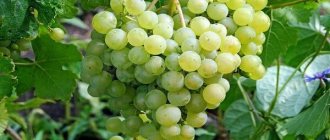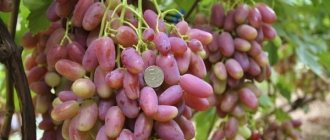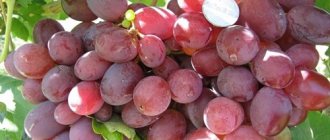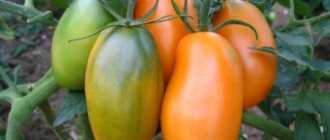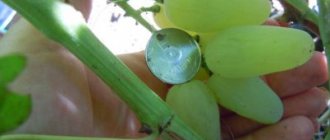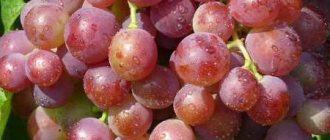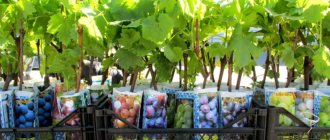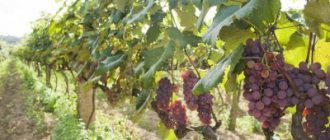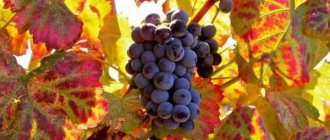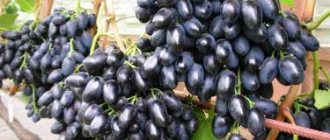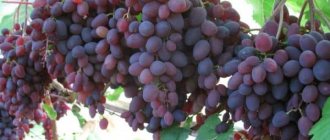Velika grape variety: history of creation
The Velika variety appeared thanks to several breeders, headed by Ivan Torodov. It was he who carried out most of the scientific work. Ivan crossed several varieties of “Alphonse Lavallee” and “Bulgara”. The result was a new variety. Velika has a feature that distinguishes it from other varieties: it is early ripening, with large fruits and beautiful appearance. After studying this variety in more detail, they decided to include it in an official state document, which contains only good varieties of various plants.
Characteristics of the Velika grape variety
Photo of Velika grape variety
This variety is perfect for making wine, so it is highly valued by gardeners who make wine.
Velika grapes are a very large variety, its bush grows very strongly, so pruning and shaping of Velika grapes begins 80-100 days after planting. The growth of grapes is so strong that gardeners often wonder if it can be stopped. This can be controlled by using a vigorous rootstock. It is better to use Monticola in this case, this will increase the size of the bunch and increase the number of fruits.
Note : A shoot of this variety should be tied to a support, where there are several levels, on average to a height of about 3-3.5 meters. The flowers of the variety do not require any additional pollination, as they do everything on their own.
A variety called “Gift to Ukraine”
It cannot be called an early subspecies of grapes. In appearance, ripening period and taste it strongly resembles the mother form “Red Delight”. Maximum productivity usually occurs in the second or third year of grape life. It is quite a popular species on the market for its taste and appearance.
Large grape varieties include Muscat Pleven. The shape of the berry is oblong, with a very pleasant, nutmeg taste. The grapes are endowed with an amber color and have rather large sizes, both the berries themselves and the canopy as a whole.
Large grape varieties include Karmakod. The berry ripens along with other popular varieties. The harvest peaks at the end of July. In "Karmakod" the berries have a pointed corner; they are first colored pink, and then dark.
It has a characteristic appearance that cannot be confused with others. The species is increasingly avoided because in some very rainy regions the grapes can crack severely. The “Natalia” variety looks very much like the well-known “Moldova” grape. The berry has a round shape, a pleasant taste and an unusual aftertaste. The variety produces huge clusters of incredible beauty. It is highly valued as an early and unusually hardy grape variety.
Velika grapes: variety description
The leaves of the Velika grape variety are slightly elongated, with cutouts. The leaf itself is smooth on top, and there are small fibers at the bottom.
Note : This variety is often used for decoration, as the leaves look very beautiful. This occurs due to the different colors of the leaves. For example, on one side they can be green with a slight tint of brown, and on the other side they are already a rich burgundy color. At the end of the summer, the bush becomes completely golden-burgundy.
The fruits are on oval-conical clusters, the berries have space between them. Each bunch averages about 700-1200 grams. If proper care has been carried out, the yield of each bunch increases to 1500-2000 grams. Length about 22 centimeters, width about 18 centimeters. The Velik variety is very large; compared to its brothers, it holds the record for size. The fruits are very large, up to 5 centimeters long, up to 3 centimeters wide, each fruit weighs on average about 20 grams. The fruit is elongated and usually the tip is slightly pointed.
Agrobiological characteristics
Plants are large, powerful, fast growing. The crown of the young shoot is greenish-bronze, shiny, without pubescence. The leaf is medium in size, five- and sometimes even seven-lobed, strongly dissected, rounded, with a smooth surface and a finely wrinkled back side. The upper lateral notches are very deep, closed with an ovoid lumen and a rounded bottom, the lower ones are less deep, but also closed. The petiole notch can have a variety of shapes: from closed narrow elliptical to open lyre-shaped. The petioles are medium in length, on the upper side they have a number of longitudinal stripes of red-brown color, tightly adjacent to each other. The teeth along the upper edge of the grape leaf blade are triangular, medium in size; on the sides - transitioning from triangular to dome-shaped. The veins on the leaves are moderately developed, without pubescence; at the base, as well as at the top, red-brown. In autumn, before falling, Velika's foliage takes on a fiery red color. The flowers of the variety are bisexual, are well fertilized by their own pollen, and there is no tendency to pea.
The clusters are large, about 18 cm long, 13 cm wide, conical or cylindrical-conical in shape, moderately dense, but not so dense as to deform the berries. The average weight of a brush is 500-700 grams, some reach a kilogram. The comb is of medium length, light green, strong. The berries are aligned within the cluster, excellent in size - with an average length of about 38.5 mm and a diameter of up to 23 mm. The largest ones reach a length of 55 mm. The shape of the grapes is oblong with pointed tops, the color is dark blue or dark purple, the average weight is 14 grams, the maximum is more than 20 grams. Velika's pulp is dense, crisp, yellowish-green in color with a harmonious, noble taste, reminiscent of the parent Asian variety Karaburnu. Uncolored juice, sugar content 16-17 grams/100 cubic meters. cm, acidity - 5−6 grams/cubic dm. The skin is of medium thickness, covered with a thick protective coating of wax, fragile and eatable. The berry's compressive strength is 2300 grams, and its tearing strength from the stem is 540 grams. The seeds are dark brown, rounded pear-shaped with a short beak, medium in size and easily separated from the pulp. In the structure of the berry, the pulp occupies 93.3%, the skin - 5.4%, seeds - 1.2%. The tasting rating of the grapes is high.
The harvest is successfully used fresh, but large dark-colored berries also look great in various home preserves - compotes and jam. The bunches have a very attractive appearance, which, coupled with excellent taste, determines the increased interest of buyers in it. According to the recognition of winegrowers engaged in cultivating the crop for commercial purposes, Velika is currently one of the most “marketable” and highly marketable varieties in its segment in terms of ripening time. In addition, it is also distinguished by excellent transportability, as well as good ability to be stored in refrigerated chambers, which significantly expands the possibilities for its implementation.
Removable ripeness of grapes occurs in the middle period. About 130 days pass from bud break to ripening (in the southern regions of our country this is the end of August), and for this the plant needs a total of at least 2700 °C active temperatures. Thus, the northern border of the possibility of growing Velika in open ground runs along the line of Saratov, Voronezh, Kursk, Chernigov, but even there there is a danger of insufficient ripening of the crop in cold years. The resistance to winter frosts of the Bulgarian guest is not high enough (-21...-22°C), and therefore, in the conditions of the domestic climate, it is grown almost everywhere as a cover crop. The variety can also be damaged by late spring frosts, but it produces a harvest even in this case due to the productivity of the replacement buds.
The grape yield is exceptionally high. In its homeland, cultivated in powerful high-standard formations, Velika shows a phenomenal result - 32-35 t/ha, or about 10 kilograms per bush with a planting density of about 3300 plants per hectare. Domestic winegrowers get no less results even with covering bushes, although the feeding area increases somewhat. It does not show a significant tendency to overload with the harvest, due to which it does not require special efforts to ration it. The bunches are well preserved on the bushes after ripening, without loss of taste and marketability. The grapes are protected from wasp damage by a fairly strong skin, but in the fall they can become easy prey for birds. Also, in unfavorable conditions associated with excessive soil moisture or a sharp change in soil moisture, a small part of the berries may crack.
Berries variety
Photo of Velika grape leaves
The berries of this variety are burgundy in color with a slight purple tint. They are not particularly bright, because when fully ripe they are covered with a safe coating that resembles wax, which makes the berries more matte and protects them. The pulp of the berry has a purple-pink hue, it is quite dense, so it crunches when bitten. There are no seeds in the pulp, so they are much more convenient to eat.
Note: The bush must be treated with Gibberellin, it removes the rudiment from the fruit.
The skin of the berry is very thin and quite dense; this type of skin helps protect the pulp from damage, that is, the fruits do not crack, do not shrink in hot weather, and are good for transportation.
Pros and cons of the variety
In order to make a firm decision whether to plant this variety, you need to learn about its pros and cons, since a description of the fruits and the plant itself is not always enough.
Pros:
- The plant is bisexual, therefore, does not require additional pollinators, and also thanks to this, the berries are large and do not crack.
- .High yield of the variety. On average, about 12 kilograms of fruit can be harvested from one grape. With proper, careful care and attention to the bush, the yield can be increased to 16 kilograms. A special feature of this variety is that the fruits can be picked from both fruit buds and replacement buds, only the berries become a little smaller.
- Long storage time. The berries are stored for a long time, only for this they should be provided with the necessary conditions. The storage location should be dry and cool, such as a refrigerator.
- Great grape taste.
- The early ripening period for grapes is Velika; the harvest will already be ripe by August.
- Excellent handling for transportation, without loss of appearance and taste.
- Wasps and other insects, trying to eat the fruits, cannot do this due to the dense shell, but birds succeed in this and therefore will have to be driven away.
Each variety has its drawbacks, and the Velik variety is no exception. Minuses:
- It grows very quickly, because of this you have to trim and shape the bush very often, which is very tiring.
- The grapes are not very frost-resistant; the variety does not tolerate frosts below -21 degrees, so it is not recommended to plant this variety in areas where it is cold.
- Poor resistance to many diseases is due to the fact that he has a weak immune system. The most popular diseases with which it becomes infected are anthracnose, oidium, and alternaria. Also, the variety will not be able to overcome phylloxera, this is an aphid that begins to destroy the roots and the entire grape system.
Aftercare for grapes
The Velika grape itself is not a variety that requires special attention. But if a gardener wants the bush to bear large and tasty fruits for a long time, then it is recommended to prune it, protect it from frost, water it daily, feed it twice a year and monitor the number of shoots.
Grape pruning
The first pruning is carried out a few months after planting. It is necessary to leave only the strongest shoots that are closest to the ground.
In the future, 3-4 ovaries should be left on each shoot. This will have a positive effect on the future weight of the berries and will not allow the vine to break under the weight of the fruit.
Protecting crops from birds and insects
Despite the fact that ripe berries are not afraid of wasp attacks, during the ripening process insects can drink all the pulp from the grapes. In this case, other insects will flock to the sweet smell of Velika. To prevent this, you need to use one of the methods to combat wasps:
- protective net for grapes;
- sweet bait (may be poisoned);
- destruction of the hive.
In addition, the net will help in bird control. Through the fine mesh, birds will not be able to reach the Velika fruits.
Preparing the crop for winter
Velika grapes are not frost-resistant varieties. Therefore, when growing a plant in the middle zone, it is necessary to take care of good protection of the grapes. The material can be used: slate, plywood, hay, mulch and artificial materials. You just need to make sure there are no insects and fungi on the material.
Difficulties of growing
The Velik variety has its own difficulties that every gardener encounters when starting to grow this variety.
- The first difficulty is careful watering, that is, due to the variety’s poor tolerance of excess water, watering must be careful. Otherwise, the root system may begin to rot and the plant will die, or a fungus will settle in the root system.
- The second difficulty is poor resistance to fungal diseases. Because of this, the place where the variety will grow must be well ventilated.
- The third difficulty is treating the plant against diseases. As we already know, the variety is very poorly resistant to many diseases. Consequently, without carrying out preventive treatments, it will not be possible to grow healthy bunches. The best preparations for treatment are fungicides. Also, this variety quickly gets used to the product, so they should alternate for better effect.
- And the last, fourth difficulty is that if the gardener does not provide the necessary care, does not take care of the bush, or grows it incorrectly, especially if the variety is grown in a climate where frosts are frequent, then the berries of the bush will become tasteless. The amount of sugar in fruits will decrease by 30-60%, which will greatly affect the taste. Very often you can find reviews from gardeners who talk about this, so it’s worth noting that such changes only occur with poor care.
Diseases and pests, methods of control and prevention
Velika grapes do not have good disease resistance. The variety is susceptible to various infections, so the gardener is obliged to treat the plant for preventive purposes. For this purpose: Albit, Ordan, Bayleton and analogues are used.
What diseases should you be wary of when growing Velika grapes:
- Alternaria - gray and brown spots;
- anthracnose - brown dry spots on the leaves;
- mildew - yellowish spots in large quantities;
- oidium - plaque and mold appear on the shoots;
- gray rot - gray plaque.
Important! All of these diseases are related to fungi, for which fungicides are used.
Other diseases are also dangerous: rubella, bacterial cancer, chlorosis, bacteriosis.
Of the insects, Velika grapes suffer the most from phylloxera or the aphid-ravager. Insects begin to destroy the bush from the root, which is why the yield first drops, and then the plant may even die.
The following actions are taken as methods of combating aphids:
- flood the bushes in water for a couple of days;
- use special drugs;
- plant Velika in sandy soil;
- leaves are burned;
- destroy infected bushes.
Reproduction methods
There are many methods of propagation, but the following methods are the most popular.
- Grafting using a lignified cutting. This method is done in part of the trunk underground. You need to cut it using a sharply sharpened knife, then you need to split it and insert the cutting. The place where the grafting was made is smeared with garden varnish and pulled together using twine.
- Grafting onto bushes of a different variety. With such grafting, the growth of the variety slows down. Thus, it becomes less complicated than it was before. The cuttings are grafted in the spring using the “split” method. The grafting height is usually about 90 centimeters.
- You can propagate grapes using part of the cutting root. This method is only possible if the cutting is absolutely healthy, otherwise it will not take root. The first harvest appears in the third year after planting.
Some secrets of a good harvest
In order for the grapevine to delight not only you but also your children and grandchildren for many decades, it is necessary to take certain measures to care for the vineyard.
- When planting seedlings in a planting hole, it is necessary to add rotted manure and compost. And also nitramofoska and ash. In this case, it is best to dig a watering pipe to the root of the plant and mulch the soil around the trunk on top. These simple operations will help your seedling during rooting and during its growth. After such planting, the bushes do not need to be fertilized for three years. But it is, of course, better to apply compost and manure under the bush annually in spring and autumn.
- You should also definitely remember about watering the vineyard; you especially need to pay a lot of attention to it during periods of drought.
- All pruning of vines and sawing of old wood is carried out with sharply sharpened and disinfected tools. Before each bush, the instrument must be wiped with alcohol or kept in a 3% formaldehyde solution.
- You should not neglect foliar feeding of bushes.
- Spraying should be carried out on schedule at least three times per season.
- You always need to tie up and prun the grape bushes; if you don’t do this, then next year the plant will become fat and will not produce a harvest.
- It should be remembered that annual overloading of the bush with crops will lead to its rapid depletion.
- If a burst or rotten berry appears on a bunch, you should never leave it, but immediately remove it and put it away. Never throw rot under the vines, as you yourself will spread the infection.
- “Velika” is a covering variety and must be well insulated for the winter, even in the southern regions.

